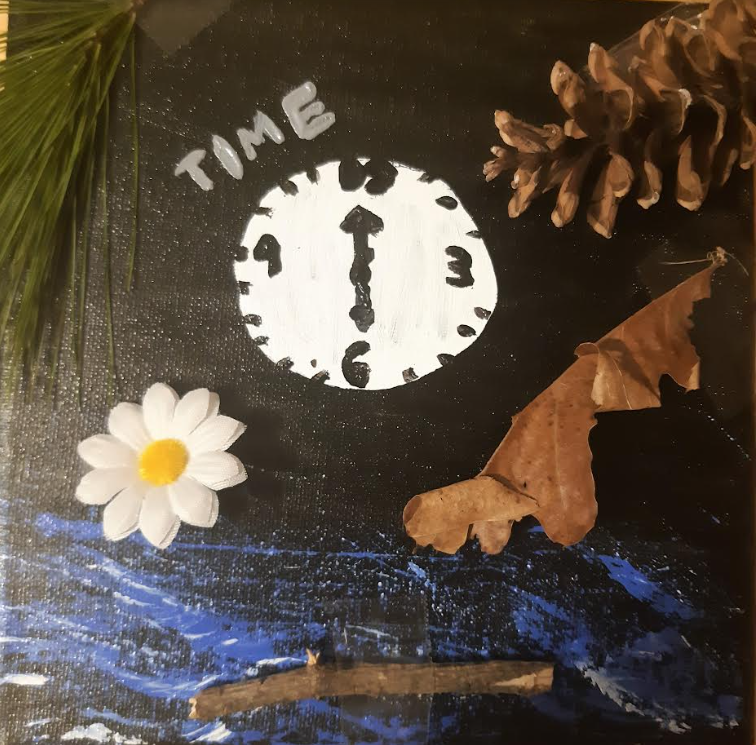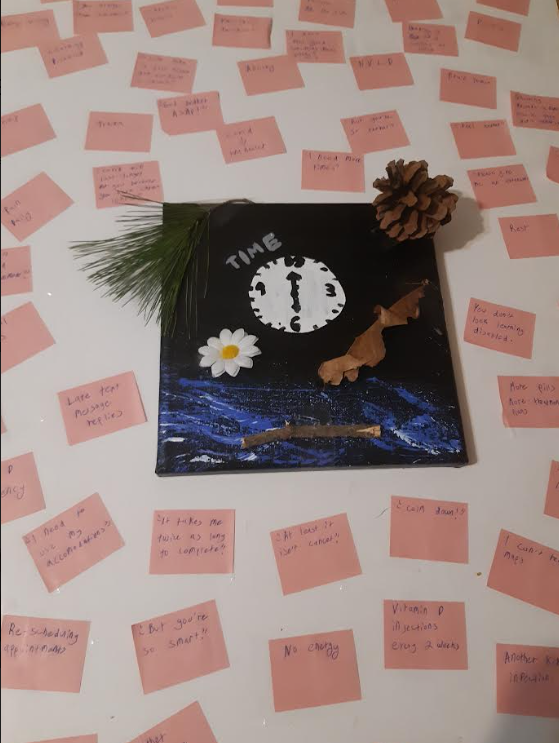Time is restrictive, and normalcy is an illusion. My piece is a personal invitation into what life is like living with a non-verbal learning disability and chronic illness. My piece illustrates how my life is a balancing act between managing and prioritizing medical appointments, tests, medication, University, work and rest. My body and mind are continually working three times more against the clock only to complete half the amount of work compared to neurotypicals. My piece is an illustrated personal collective of ableism, self-care, resiliency, and access needs. I used a black acrylic background to highlight how time becomes immeasurable. The various nature objects express my continual need to be in touch with nature as it’s critical to my self-care. I incorporated the use of a pine needle branch to paint water, as water is healing and nourishes my soul. The sticky notes reflect echoes of ableist comments I’ve received. My goal is to emphasize how Crip time is necessary for my survival.
Recently, I completed my Disability Studies University thesis and incorporated the concept of crip time and crip ritual into the art pieces I created. I used creation as research as one of the three research methodologies I used. The meaning of crip ritual embraces disability culture as it refuses normative hierarchies and creates a collective space of care, self-care and access (crip ritual,n.d). Being in nature is something I do, to help nurture one’s soul as a disabled person. Crip rituals are defined as any method of self-care disabled people find comforting. I also work in “crip time”. I take twice as long to finish assignments and tasks which most neurotypicals would find easy to complete. As Ellen Samuels (2017) argues, “crip time means listening to the broken languages of our bodies, translating time, honoring their words” (Samuels,2017). I often find myself listening to my body and having to pause and take more breaks than most neurotypicals would.
While having both a learning disability and chronic illness, my body decides for me when I need to pause and take a break. Time becomes irrelevant, as my body bends the clock and decides my needs for me. In a neurotypical world, I feel I am always chasing time and trying to “catch up”. The concept of “crip time” reflects how disabled peoples experience time and space differently than able-bodied peoples (Samuels,2017). Other ways crip time can be incorporated is through access and accommodations needs. Often, I’ve had to ask for assignment extensions as I work in “crip time”. Ableism is woven into our everyday experiences as disabled people, crip time is a principle of disability justice and is dependent on my own access needs as a disabled and chronically-ill woman. I may work at a different pace than other neurotypicals, but bending the clock to meet my needs reflects the ability to get things done at a different pace. Please consider the concept of “crip time” the next time you ask why someone with NVLD may take a little longer with completing certain everyday tasks.
Share your own story








